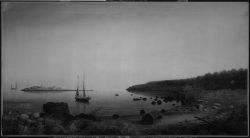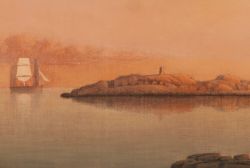loading 
Fitz Henry Lane
HISTORICAL ARCHIVE • CATALOGUE RAISONNÉ • EDUCATIONAL RESOURCE
An online project under the direction of the CAPE ANN MUSEUM
An online project under the direction of the CAPE ANN MUSEUM
Catalog entry
inv. 1
Norman's Woe, Gloucester Harbor
Gloucester Harbor; Gloucester Harbor (lower right: skeleton of a ship); Norman's Woe, Gloucester
1862 Oil on canvas 27 1/4 x 49 1/4 in. (69.2 x 125.1 cm) Inscribed lower right (on tree branch): 1862 F.H.L.
|
Related Work in the Catalog
Supplementary Images
Provenance (Information known to date; research ongoing.)
Mervin Piper, Gloucester, Massachusetts
Kennedy Galleries Inc., New York
Margaret Farrell Lynch, Gloucester, Mass.
Cape Ann Museum, Gloucester, Mass., 1999
Exhibition History
Cape Ann Historical Museum, Gloucester, Massachusetts, The Mysteries of Fitz Henry Lane, July 7–September 16, 2007., no. 9, ill. in color, p. 58.
Traveled to: Spanierman Gallery, New York, N.Y., 4–1, 2007.
Traveled to: Spanierman Gallery, New York, N.Y., 4–1, 2007.
Published References
Wilmerding, John. Fitz Hugh Lane, 1804–1865: American Marine Painter. Salem, MA: The Essex Institute, 1964., p. 63, Appendix A, #106, Gloucester Harbor.
The American Neptune, Pictorial Supplement VII: A Selection of Marine Paintings by Fitz Hugh Lane, 1804–1865. Salem, MA: The American Neptune, 1965., plate XXVI, no. 106, Gloucester Harbor. ⇒ includes  text
text
Wilmerding, John. Fitz Hugh Lane. New York: Praeger, 1971.
Wilmerding, John, ed. American Light: The Luminist Movement, 1850–1875. Washington, DC: National Gallery of Art, 1980., fig. 61, p. 68, text, pp. 71, 78, Norman's Woe, Gloucester.
Wilmerding, John. Fitz Henry Lane. Gloucester, MA: Cape Ann Historical Association, 2005. Reprint of Fitz Hugh Lane, by John Wilmerding. New York: Praeger, 1971. Includes new information regarding the artist's name., ill. 79.
Craig, James. Fitz H. Lane: An Artist's Voyage through Nineteenth-Century America. Charleston, SC: The History Press, 2006., pl. 30.
Wilmerding, John. "Fitz Henry Lane & Mary Blood Mellen." American Art Review 19, no. 4 (2007)., p. 169, 175.
Wilmerding, John. Fitz Henry Lane & Mary Blood Mellen: Old Mysteries and New Discoveries. New York: Spanierman Gallery, 2007., no. 9, ill., p. 10 (detail), text, p. 58. ⇒ includes  text
text
John Wilmerding, Karen Quinn, Marcia Steele, et.al. Report on scholars' gathering in association with the exhibition Fitz Henry Lane & Mary Blood Mellen: Old Mysteries and New Discoveries. New York: Terra Foundaation for American Art, November 15, 2007. Organized by the Cape Ann Museum and Spanierman Gallery. ⇒ includes  text
text


Commentary
This is the larger and more horizontal painting of two versions taken from the sketch Norman's Woe, 1861 (inv. 114). It may have been Lane’s first attempt, as it more closely follows the drawing, particularly in its more horizontal format, and in the extent of the foreground foliage. The other version, The Western Shore with Norman's Woe, 1862 (inv. 18), is less horizontal and has a simplified composition. In this 1862 composition, the skeleton of a double-ended yawl boat rotting on the beach has been added, with a log lying over it that leads the eye out to the two-masted pleasure craft and then out to the rock of Norman’s Woe glowing in the distance.
This is a fascinating painting in that its execution may contain evidence of both Lane's and his student Mary Mellen’s hand. Based on recent research stimulated by the exhibition and companion book Fitz Henry Lane and Mary Blood Mellen: Old Mysteries and New Discoveries, scholars posit that Lane may have turned over some parts of his paintings to Mellen for completion. Commonly called the studio system, it was a method employed by many European painters beginning in the Renaissance in order to increase their output and take on larger commissions.
In this case, it is theorized that Lane transferred the drawing and laid in the basic composition. It is likely that he painted a large portion of the foreground detail, the boat skeleton, rocks, and shoreline. Where Mellen’s hand seems most evident is in the sky, clouds, and general coloration. She tended to use much stronger reds in the sky and was not as proficient with the delicate glazes that Lane had mastered. She applied more paint than Lane and her edges were not as crisp—evident in some of the rock detail on the distant shore and on Norman’s Woe. Note the differences in the subtle treatment of the sky in Lane’s other version, which shows no sign of Mellen’s involvement.
This is not the only Lane painting with evidence of Mellen’s hand (or possibly the hand of an unknown student). Here Lane has signed and dated the work, which he did not always do, so he is clearly satisfied with the outcome and with putting it into the world as his work.
This theory of Mellen’s participation in some of Lane’s work is based only on stylistic evidence relating to Mellen’s paint application, line technique, and color usage. It is further corroborated—though not confirmed—by comparisons with her direct copies of Lane paintings and her later work after Lane’s death. We as yet have no direct documentary evidence of this practice; thus it remains a fascinating subject for further research. The Cape Ann Museum is fortunate to have both of these paintings that are based on the same drawing of Norman's Woe, so viewers are able to see them together and to make their own comparisons.
– Sam Holdsworth